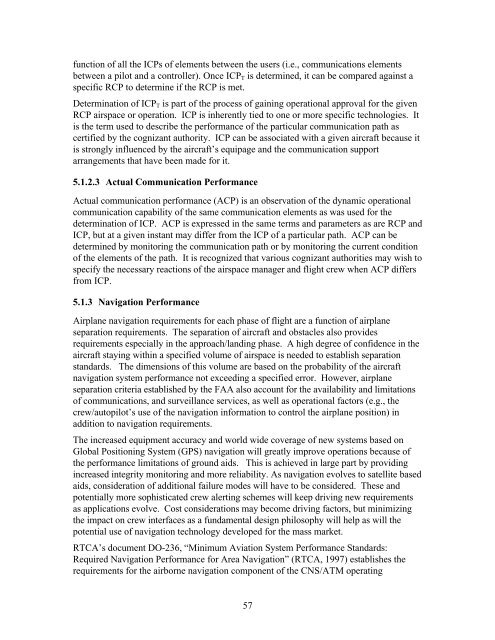Air Traffic Management Concept Baseline Definition - The Boeing ...
Air Traffic Management Concept Baseline Definition - The Boeing ...
Air Traffic Management Concept Baseline Definition - The Boeing ...
Create successful ePaper yourself
Turn your PDF publications into a flip-book with our unique Google optimized e-Paper software.
function of all the ICPs of elements between the users (i.e., communications elements<br />
between a pilot and a controller). Once ICP T is determined, it can be compared against a<br />
specific RCP to determine if the RCP is met.<br />
Determination of ICP T is part of the process of gaining operational approval for the given<br />
RCP airspace or operation. ICP is inherently tied to one or more specific technologies. It<br />
is the term used to describe the performance of the particular communication path as<br />
certified by the cognizant authority. ICP can be associated with a given aircraft because it<br />
is strongly influenced by the aircraft’s equipage and the communication support<br />
arrangements that have been made for it.<br />
5.1.2.3 Actual Communication Performance<br />
Actual communication performance (ACP) is an observation of the dynamic operational<br />
communication capability of the same communication elements as was used for the<br />
determination of ICP. ACP is expressed in the same terms and parameters as are RCP and<br />
ICP, but at a given instant may differ from the ICP of a particular path. ACP can be<br />
determined by monitoring the communication path or by monitoring the current condition<br />
of the elements of the path. It is recognized that various cognizant authorities may wish to<br />
specify the necessary reactions of the airspace manager and flight crew when ACP differs<br />
from ICP.<br />
5.1.3 Navigation Performance<br />
<strong>Air</strong>plane navigation requirements for each phase of flight are a function of airplane<br />
separation requirements. <strong>The</strong> separation of aircraft and obstacles also provides<br />
requirements especially in the approach/landing phase. A high degree of confidence in the<br />
aircraft staying within a specified volume of airspace is needed to establish separation<br />
standards. <strong>The</strong> dimensions of this volume are based on the probability of the aircraft<br />
navigation system performance not exceeding a specified error. However, airplane<br />
separation criteria established by the FAA also account for the availability and limitations<br />
of communications, and surveillance services, as well as operational factors (e.g., the<br />
crew/autopilot’s use of the navigation information to control the airplane position) in<br />
addition to navigation requirements.<br />
<strong>The</strong> increased equipment accuracy and world wide coverage of new systems based on<br />
Global Positioning System (GPS) navigation will greatly improve operations because of<br />
the performance limitations of ground aids. This is achieved in large part by providing<br />
increased integrity monitoring and more reliability. As navigation evolves to satellite based<br />
aids, consideration of additional failure modes will have to be considered. <strong>The</strong>se and<br />
potentially more sophisticated crew alerting schemes will keep driving new requirements<br />
as applications evolve. Cost considerations may become driving factors, but minimizing<br />
the impact on crew interfaces as a fundamental design philosophy will help as will the<br />
potential use of navigation technology developed for the mass market.<br />
RTCA’s document DO-236, “Minimum Aviation System Performance Standards:<br />
Required Navigation Performance for Area Navigation” (RTCA, 1997) establishes the<br />
requirements for the airborne navigation component of the CNS/ATM operating<br />
57
















